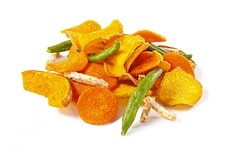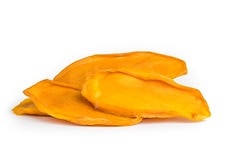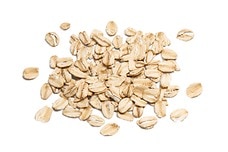The Complete Guide to a Gluten-Free Diet
Approximately 20% of Americans now intentionally include gluten-free products in their diets (Gallup, 2015). This reflects a growing concern about the health effects of gluten products and an intention to make healthier dietary choices. While there is nothing dangerous about gluten per se, a certain subset of the population experiences gastrointestinal distress and other symptoms when they eat foods that contain gluten. This could be due to a condition known as celiac disease or because of non-celiac gluten sensitivity. Following a gluten-free diet is the only treatment for these ailments.
What Is Gluten?
Gluten is a type of protein that is found in certain grains and grain-based products (Celiac Disease Foundation, 2015). The gluten in food acts as a glue-like substance that helps foods maintain their shape. For example, breads are often high in gluten, which gives them their chewy texture. Wheat, rye, and barley are the primary grains that contain gluten.
Health Concerns Associated with Gluten
Many people have grown concerned about the presence of gluten in foods, but it is important to separate different types of health problems associated with gluten.
Slightly less than 1% of the population has a condition known as celiac disease. Celiac disease is an immune system reaction to the presence of gluten. For people with the disease, eating even a trace amount of gluten triggers a strong immune response within the small intestine (Mayo Clinic, 2013). If a person continues to eat gluten, this leads to chronic inflammation that damages the inner lining of the small intestine. When the lining becomes damaged, it is difficult to properly absorb nutrients, which can lead to malnutrition. In severe cases, this malnourishment can damage the nervous system, brain, liver, bones, and other organs.
The majority of people who follow a gluten-free diet do not have celiac disease. Rather, they have gluten intolerance, sometimes called non-celiac gluten sensitivity. There has been debate about the physiological origins of non-celiac gluten sensitivity, but people with the condition avoid gluten because of its ill effects on their health.
Symptoms of Celiac Disease and Gluten Sensitivity
Celiac disease affects 1 in every 133 people (UCLA Division of Digestive Diseases, n.d.). Unfortunately, more than 80% of people with celiac disease remain undiagnosed, in part because their symptoms are not specific to the disease. The most common symptoms of celiac disease include:
- Abdominal bloating
- Diarrhea
- Constipation
- Fatigue
- Iron deficiency anemia
- Weight loss
- Osteoporosis
- Malnutrition
The only way to assess gluten sensitivity is through an elimination diet. If a person who was experiencing a set of gluten sensitivity symptoms no longer has any symptoms after completely eliminating gluten from their diet then that is a sign that he or she is suffering from gluten sensitivity. Some common symptoms of gluten sensitivity include (UCLA Division of Digestive Diseases, n.d.):
- Lack of energy
- Chronic feelings of lethargy
- Bloating
- Gas
- Abdominal pain
- Abdominal cramping
- Diarrhea
- Constipation
- Mental fatigue (sometimes described as a “brain fog”)
Foods that are High in Gluten
The most important thing when following a gluten-free diet is to avoid wheat, rye, barley, and triticale (a common wheat-rye hybrid). Unfortunately, this is easier said than done. These gluten-containing items make their way into a variety of everyday foods. The following foods often contain gluten (Celiac Disease Foundation, n.d.):
- Wheatberries
- Semolina flour
- Farro
- Graham
- Spelt
- Rye
- Triticale
- Malted milk
- Malt extract
- Malt syrup
- Malt vinegar
- Brewer’s yeast
- Beer
- Pasta
- Crackers
- Pretzels
- Bagels
- Cornbread
- Ramen noodles
- Egg noodles
- Panko breadcrumbs
- Granola
- Corn flakes
- Flour tortillas
- Soy sauce
- Gravy
- Energy bars or granola bars
- French fries
- Candy or candy bars
- Soup
- Potato chips
- Salad dressings
- Tortilla chips
- Vegetarian meat substitutes made with seitan
- Preseasoned meats
- Processed lunch meats
How to Follow a Gluten-Free Diet
The list of foods that contain gluten seems long and daunting, but many nutritious foods make the cut. As with any diet plan, it is important for those following a gluten-free diet to receive a healthy blend of nutrients. This includes whole grain products, lean protein, and healthy fats. At first, finding sources of complex carbohydrates that do not contain gluten may seem like a challenge. Consider the following gluten-free grains as a way to boost your intake of complex carbohydrates and fiber:
- Amaranth
- Corn
- Buckwheat
- Montina
- Millet
- Sorghum
- Rice
- Quinoa
- Teff
- Wild rice
Although oats are naturally gluten-free, they may experience cross-contamination during harvesting or post-harvest processing. Always check the label for gluten-free rolled oats to be safe.
Most other whole foods are naturally gluten free (Celiac Disease Foundation, 2015). Skinless chicken breasts, ground turkey, fish, seafood, or lean beef are high in protein and gluten free. Just avoid pre-marinated meats, as marinades often contain soy sauce, starch, or other gluten-containing products. For vegetarian sources of protein, eat nuts, seeds, tofu, eggs, nonfat dairy products, beans, and legumes. These high-protein foods give your body amino acids while keeping you satiated.
Finally, it is important to get plenty of heart-healthy fats in your gluten-free diet. Avocados, seeds, nuts, olive oil, chia seeds, and fatty fish are excellent sources of polyunsaturated and monounsaturated fats.
Considerations When Transitioning to a Gluten-Free Diet
When following a gluten-free diet, you will need to get in the habit of checking food labels. Any product that contains wheat or food additives like modified food starch or malt flavoring must be avoided. Also be vigilant about the presence of gluten in medications or vitamins. Some pharmaceutical companies use gluten as a binding agent in drugs or supplements (Mayo Clinic, 2013).
When transitioning to a gluten-free diet, it is important to avoid cross-contamination. For example, wiping down cutting boards after cutting bread or avoiding sharing utensils with foods that contain gluten can keep you safer. If you share a household with someone who does not follow a gluten-free diet, you may want two toasters, cutting boards, and other commonly used items to avoid cross-contamination.
One of the greatest challenges of following a gluten-free diet is eating out at restaurants. Making foods at home allows you to control the ingredients, while risk of cross-contamination or limited options is higher with restaurant meals. Always inform restaurant staff of your dietary needs, and ask for recommendations for gluten-free meals (Mayo Clinic, 2013).
Gluten-Free Recipes
Below is a small sample of delicious dishes that do not contain gluten, which contain nutrients to contribute to a healthy diet. Be sure to check out our full list of gluten-free recipes here.
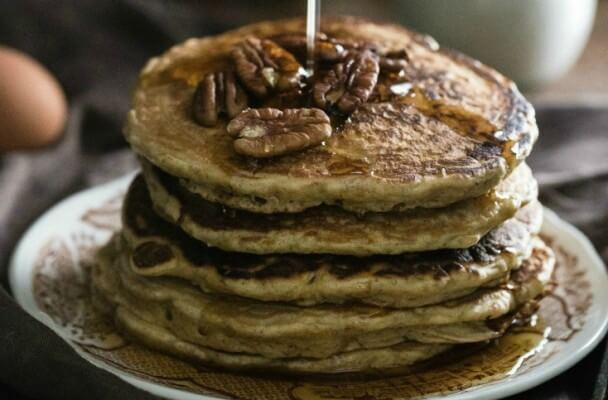
Quinoa Pancakes Recipe
Always a delicious way to start the day, pancakes provide a hearty source of starches to supply the enduring energy needed in the morning. This gluten-free variety utilizes quinoa to provide a familiar palate without any gluten.
Ingredients: Quinoa, whole wheat pastry flour (or brown rice flour for gluten-free cakes), eggs, milk, maple syrup or honey, raw pecans, baking powder, vanilla extract, salt.
Total Time: 15 minutes
| Yield: 7 pancakes
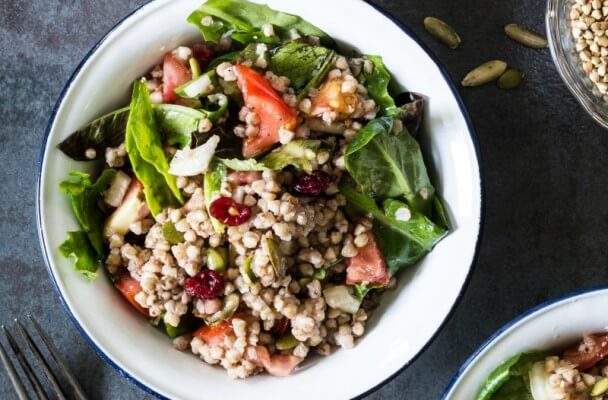
Buckwheat Salad Recipe
This buckwheat salad recipe uses the plant-based substitute or standard grains to add heft to your lunch or dinner without relying on a gluten-based grain. Try this scrumptious recipe today!
Ingredients: Mixed greens, buckwheat, tomatoes, onion, raw pumpkin seeds, dried cranberries, rice wine vinegar, sesame oil, salt, black pepper.
Total Time: 15 minutes
| Yield: 5 servings
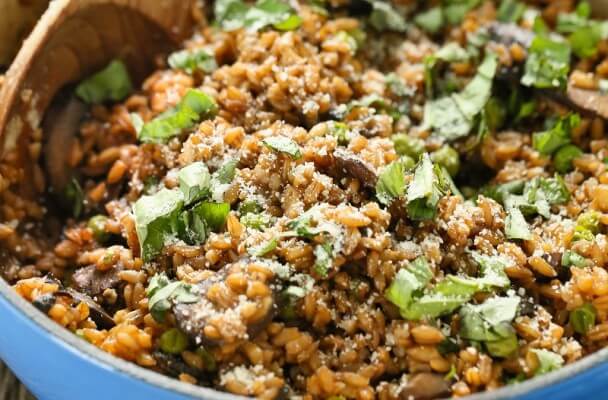
Farro Risotto with Mushrooms Recipe
A filling entree with a full flavor, this risotto combines a blend of herbs and cheese to create a scrumptious savor that defines the dish. Farro acts as a gluten-free base to carry the heft of the dish and supply a vegetarian source of both fiber and protein.
Ingredients: Organic pearled farro, sliced mushrooms, garlic cloves, extra virgin olive oil, frozen peas, salt, fresh basil, parmesan cheese, hot water.
Total Time: 1 hour, 15 minutes
| Yield: 6 servings
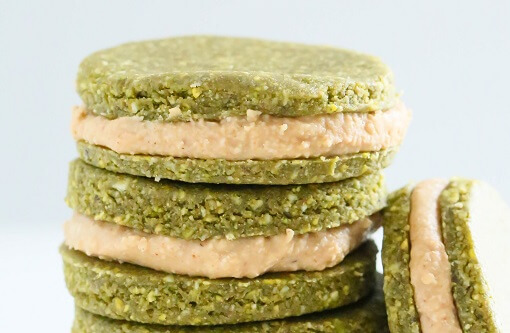
No-Bake Pistachio Cookies Recipe {gluten-free, vegan}
These sandwich cookies give traditional varieties a run for their money with the distinctive palate of pistachio and coconut. Each cookie is a surprisingly wholesome sweet that makes for a great snack or after-dinner dessert.
Ingredients: Pistachios, unsweetened shredded coconut, gluten-free rolled oats, maple syrup, moringa powder, water, vanilla extract, cashews, almond butter, vanilla, coconut oil.
Total Time: 20 minutes
| Yield: 16 cookies
Gluten-free Products
We have an abundance of products that are GFCO and USDA certified gluten-free. Find a great guide to our gluten-free products, or peruse a list of our favorite gluten-free snacks. Also, be sure to try some of our favorite gluten-free products listed below!
Healthy Eating
- Healthy Snacks
- Healthy Highlights
- 5 Uses for Cacao Powder
- 5 Ways to Eat Farro
- 6 Best Gluten-Free Foods
- Alcohol and the Body
- Almond Flour Recipes
- Anti-Aging Superfoods
- Beat the Afternoon Slump
- Benefits of a Plant-Based Diet
- Benefits of Baobab
- Benefits of Cashews
- Benefits of Coconut Oil for Hair
- Benefits of Coconuts
- Benefits of Dates
- Benefits of Fenugreek
- Benefits of Garcinia Cambogia
- Benefits of Goji Berries
- Benefits of Kale Chips
- Benefits of Monk Fruit Sweetener
- Benefits of Peanuts
- Benefits of Pecans
- Benefits of Pistachios
- Benefits of Pumpkin Seeds
- Benefits of Spelt Flour
- Benefits of Steel Cut Oats
- Benefits of Sunflower Seeds
- Benefits of Tiger Nuts
- Benefits of Turmeric
- Benefits of Walnuts
- Benefits of Wheatgrass
- Best Food Fads
- Cacao vs Cocoa
- Caffeine-Free Energy Foods
- Chocolate That's Good for You
- Diet vs. Exercise
- Fat Burning Foods
- Food Myths Debunked
- Foods for Bone Density
- Foods for Colon Health
- Foods for Healthy Hair
- Foods for Healthy Skin
- Foods to Help Sleep
- Foods to Reduce Stress
- Green Tea Benefits
- Healthy Baking Flours
- Heart Healthy Habits
- High Protein Health Risks
- How to Boost Your Metabolism
- How to Lose Weight While Aging
- How to Throw a Vegan BBQ
- Kaniwa vs Quinoa
- Little Health Foods
- Low-Carb: Fad or Friend?
- Making Healthier Desserts
- Mediterranean Diet Meal Plan
- Natural Beauty Products
- Nuts for Weight Loss
- Preparing Vegan Meals
- Preventing Muscle Degeneration
- Rare Superfoods
- Reduce Sugar Intake
- Save Time By Going Vegan
- Smarter Snack Swaps
- Smoothie Ingredients
- Soy Protein vs Whey Protein
- Starting a Plant-Based Diet
- Steel Cut vs Rolled Oats
- Sugar Substitutes
- Vegan Proteins
- Vegan Substitutions for Fall Recipes
- Why Go Vegan
- Healthy Meals
- Healthy Recipes
- Sports Nutrition
- Vitamins, Minerals & Nutrients

